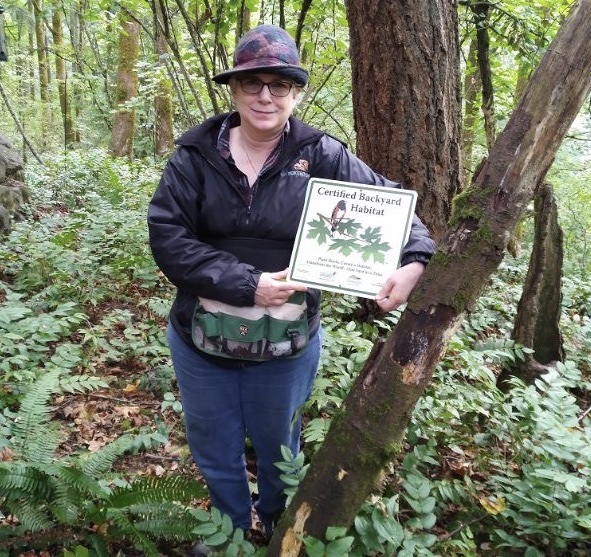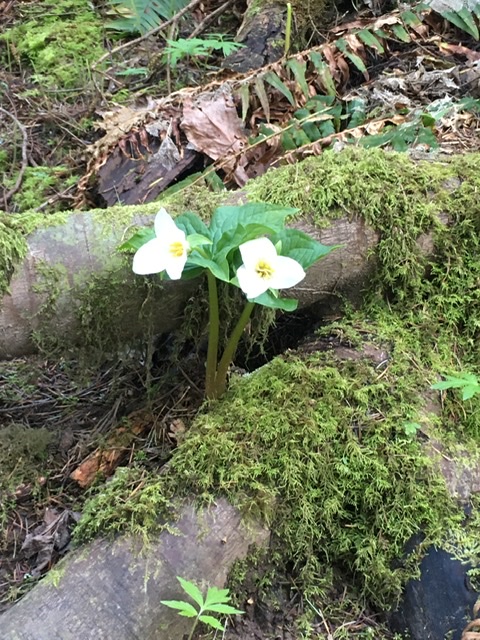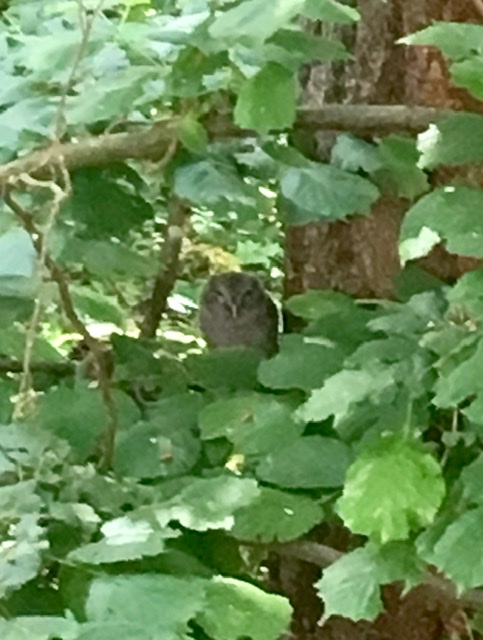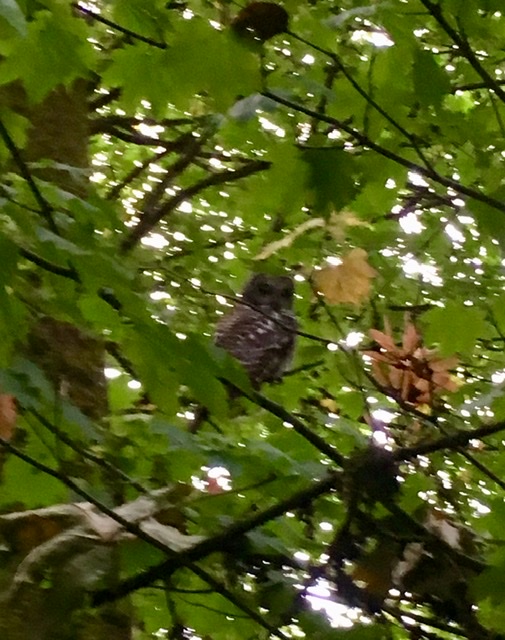Site Information: Located in SW Portland, Debbie has a part sun, part shade yard with a 40-degree slope, and a conservation easement covering 65% of the lot.

What inspired you to enroll in the Backyard Habitat Certification Program?
On a walk with my dog, I noticed one of the Certification signs in a neighbor’s yard. I looked into it and realized that my backyard could qualify for Platinum certification with very few changes. We live in a conservation area within the city limits of Portland, which means we can only “touch” 3,500 square feet of the lot; the rest is required to have only native species. The natural area covers 6,500 square feet of our 10,000 square feet lot (65%).

How would you describe your habitat?
The backyard backs to Loll Nature Park, previously West Portland Park. The property was already wooded, with just a few things left to do to qualify for Platinum. Little did I know exactly how many blackberry and ivy vines I would remove to achieve my goal.
After clearing out the weeds that were there, I was left with a little piece of paradise within the city limits. Part sun, part shade with a 40-degree slope, birds love my backyard; it doesn’t hurt having a suet feeder with a tail-board. All types of birds come to eat from it, including five kinds of woodpeckers: Downy, Hairy, Flicker, Red Naped Sapsucker, and my favorite, the Piliated. I also get the rare White-Breasted Nuthatch. I have Barred owls and Goshawks occasionally visit, looking for a meal; one year, a pair of Western Screech-Owls nested nearby and raised their young just five feet from the patio. I can’t forget to mention I can see deer and hear coyotes at night towards the bottom of the property.

What are your top three favorite native plants and why do you love them?
It’s tough to choose a top three because every native plant in my backyard coexists with others that create a paradise. I’m currently adding new native plants to fill in spaces that were once taken over by invasive plant species. Ivy was especially hard to get rid of, but I did finally succeed.
Since clearing out the invasive plant species, I can’t believe how many Western Trilliums were waiting to reach up to the sun; they’re all over my backyard now. This native plant is an early-season favorite whose white flowers shine brightly and turn pink toward the end of their life. I always look forward to seeing my Inside-Out flowers when they’re popping up everywhere and flowering, even spreading into an area where ivy once was. The season is just getting started, so it’ll be exciting to see what happens next. The third one is a toss-up – Red Twig Dogwood and its year-round beauty, Pacific ninebark with what promises to be beautiful, Blue Elderberry, Black Twinberry (which is flowering already and was just planted last November), and more. I’m amazed that all native plants and trees I planted in the fall are doing so well!

What changes have you observed as a result of creating habitat?
There have been many changes from my blood, sweat, and tears clearing out all invasive species from my backyard. Flowering plants just waiting to see the sun didn’t disappoint, especially the Trilliums, but the season at this point is still too early to tell what other fun surprises are in store to see. More birds that like to stay close to the ground have decided to move in and make my backyard their homes. They have more hiding places and protection under Dull Oregon Grape and Sword Ferns to escape from any raptors that venture into my backyard.

What were the two most significant challenges you encountered while creating habitat, and how did you address them?
The most significant challenge was a 40-degree slope to work on, and constantly trying to avoid rolling downhill, especially when pulling at stubborn weeds. This leads me to the second significant challenge that involved two specific invasive plant species, blackberry vines and ivy. Both had huge root balls that needed to come out. I did a lot of digging in the dirt, searching for them so it wouldn’t be too difficult doing maintenance each year to remove anything trying to grow back after removal.
I’m only allowed to work in my yard from May to November because my property is in an environmental zone.

What resources did you find especially helpful?
During my initial Backyard Habitat site visit, the best reference was when I learned new things like which plants were native and what species they were. Lorena, the Habitat Technician, made me realize how special my backyard is. One of the hardest native plants to grow, red huckleberry, was well established in my property long before I moved in. It is one of the tallest specimens that Lorena has ever seen.
Another key resource I have been using is the Metro’s Native Plants for Willamette Valley Yards booklet that contains many native plant species I can put in my yard, complete with pictures and descriptions. Just look for the “PPL” symbol on top of the map that indicates the species is in the Portland Plant List.
How do you enjoy your Backyard Habitat throughout the different seasons? What are its highlights in each season?
I love sitting at my dining room table, looking out the sliding glass doors watching all the different birds that come to eat at the suet feeder. Sometimes it reminds me of an airport where planes are waiting to take off, only it’s birds waiting either in trees or on deck railing for their turn at the feeder. There are times when a bigger bird comes along and scatters everyone who was patiently waiting for their turn to eat. I especially enjoy seeing the piliated woodpeckers when they come to eat at the suet feeder. The white-breasted nuthatches that stop by are rare gems in this area.
Otherwise, it’s fun to watch all the different plants make their entrances with beautiful flowers at different times of the year. I look forward to watching all the plants I recently put into the yard to see if they make it and what they become over the years.

What part of your backyard habitat are you most proud of?
I’m very proud of the entire backyard because it’s a cohesive unit working together to be a paradise. After that, clearing out all the ivy, especially on the right side of the yard. There was really where I spent the most time and reaped the greatest reward when I finished and started seeing native plants slowly come back to life.
Is there anything else you’d like to add about your journey?
Just this piece of advice, don’t get discouraged because it’s taking longer than you thought it would to get your Backyard certification. Go in knowing you’re going to invest many hours and be a lot of hard work, but the rewards you reap at the end are indescribable. I have multiple sclerosis (MS) and am very limited to the amount of time I can work in my backyard without draining almost all of my energy. One hour a day was all I could do, which is why it took four years to accomplish my goal of Platinum certification. Working in my yard is therapeutic to me, a chance to get outside, listen to concerts of birds, watch what goes on around me while I’m working, and relieve stress.
Also, make sure to wear a weightlifting belt to avoid lower back pain as you never know how much exertion it might take to pull a weed or move a heavy limb of a tree, wear a gardening tool belt, so everything’s right there at your disposal, and you don’t get frustrated trying to remember where you last used or saw it (see my certification picture to see what it looks like), use proper tools and keep them sharpened with a file, so they work more efficiently (my go-to tools I keep on my belt are a dandelion puller and a hand bypass pruner), wear a baseball cap or other cover on your head to give you shade and keep any tree parts out of your hair and most important – keep water nearby to stay hydrated!
When I enrolled in the program, many invasive plants took over the property, especially ivy and blackberry vines. Lorena, the Habitat Technician who visited in 2016, recently contacted me regarding my bioswale. She now works for the Stormwater Stars program, and she was looking for demo sites, which my swale qualified. I took the opportunity to show her all the progress I accomplished in 5 years. She was the one who pointed out that I was probably ready for Platinum certification.